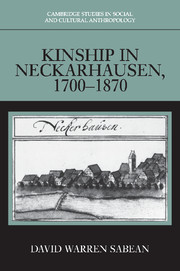Book contents
- Frontmatter
- Contents
- List of tables
- Abbreviations
- Abbreviations of sources
- On reading kinship diagrams
- Glossary
- Preface
- Introduction
- Cohort I (1700–1709)
- Cohort II (1740–1749)
- Cohort III (1780–1789)
- 11 Consanguinity as a principle of alliance
- 12 The formation of an alliance system
- 13 Ritual kinship and alternative alliance
- 14 Naming and patrilineal alliance
- Cohort IV (1820–1829)
- Cohort V (1860–1869)
- Conclusion
- Appendix
- Bibliography
- General index
- Index of villagers
11 - Consanguinity as a principle of alliance
Published online by Cambridge University Press: 04 August 2010
- Frontmatter
- Contents
- List of tables
- Abbreviations
- Abbreviations of sources
- On reading kinship diagrams
- Glossary
- Preface
- Introduction
- Cohort I (1700–1709)
- Cohort II (1740–1749)
- Cohort III (1780–1789)
- 11 Consanguinity as a principle of alliance
- 12 The formation of an alliance system
- 13 Ritual kinship and alternative alliance
- 14 Naming and patrilineal alliance
- Cohort IV (1820–1829)
- Cohort V (1860–1869)
- Conclusion
- Appendix
- Bibliography
- General index
- Index of villagers
Summary
Kinship in Neckarhausen could be constructed around two axes: affinity and consanguinity. But both principles always formed an interlocking system and cannot be seen as simple alternatives. At the beginning of the century, any marriage alliance constructed through affinal links produced in its turn children who were cousins. As demonstrated in preceding chapters, cousins, especially cousins related through fathers, came to be important politically, economically, and socially. It is also apparent that when cousins began to marry each other, they connected their immediate families as in-laws. Despite the fact that ties created from both marriage alliance and blood interconnected and supported one another, however, it is still possible to describe the history of kinship in Neckarhausen during the eighteenth century in terms of a transformation from the affinal to the consanguineal axis. At the beginning of the century, no villagers married anyone connected by blood, but by the end of the century many families had constructed durable alliances through a repetitive pattern of consanguineal unions. Consanguineal marriages, however, were unevenly distributed in the population (see Chapter 12). They spread from the small group of dominant political families to encompass the wealthier village stratum as a whole during a period of increasing social differentiation.
By the 1780s, the population of Neckarhausen had finally recovered from its disastrous decline during the Thirty Years' War.
- Type
- Chapter
- Information
- Kinship in Neckarhausen, 1700–1870 , pp. 208 - 216Publisher: Cambridge University PressPrint publication year: 1997



